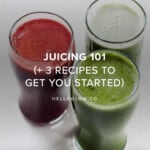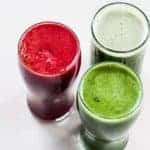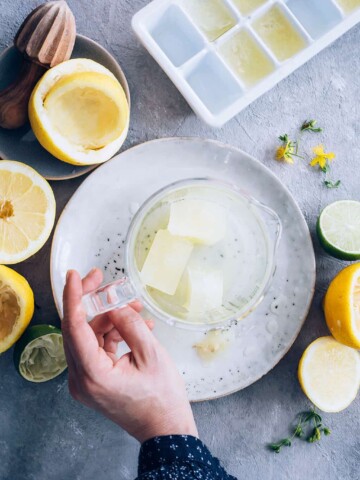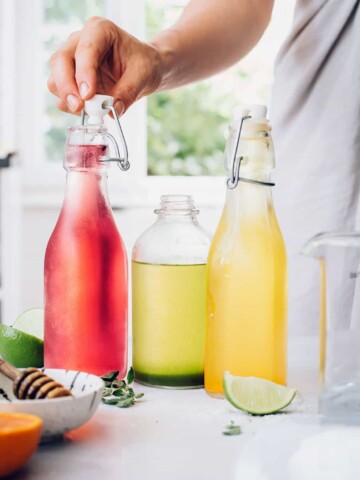A few years ago, I decided to purchase a juicer. That was a huge step for me. I didn’t realize just how quickly I’d get hooked on fresh vegetable and fruit juice recipes! (I even did a crazy 10-day juice fast!)
Juicing has so many amazing health benefits, but it might also leave you wondering if it’s really something you want to dabble in or if you’d rather just chew your fruit and veggies.
When I first started juicing, I got a lot of questions from family and friends. Why are you doing this? Isn’t making smoothies the same thing? How does it taste? What kind of juicer should I get? So this juicing 101 guide is an answer to all those questions, plus everything I've learned in the process.

Jump to:
- Best Produce for Juicing
- Tips + Tricks for Juice Newbies
- Basic Healthy Juice Recipes
- 1. Tropical Immune Boost Juice
- More Immune Boosting Juice Blends
- 2. Minty Melon Energizing Juice
- More Energizing Juice Blends
- 3. Zingy Green Detox Juice
- More Green Detox Juice Ideas
- Equipment
- How To Juice in a Blender
- Storing Fresh Juice
- Juicing FAQ
- 📖 Recipe
- References
Best Produce for Juicing
I started juicing as a way to get more nutrients from fresh fruits and veggies into my day. I mean, I can only eat so much salad!
It’s been a great way to supplement my otherwise healthy diet. That's also true for people who maybe aren’t eating a very healthy diet. Everyone can benefit from consuming more fruits and veggies [source].
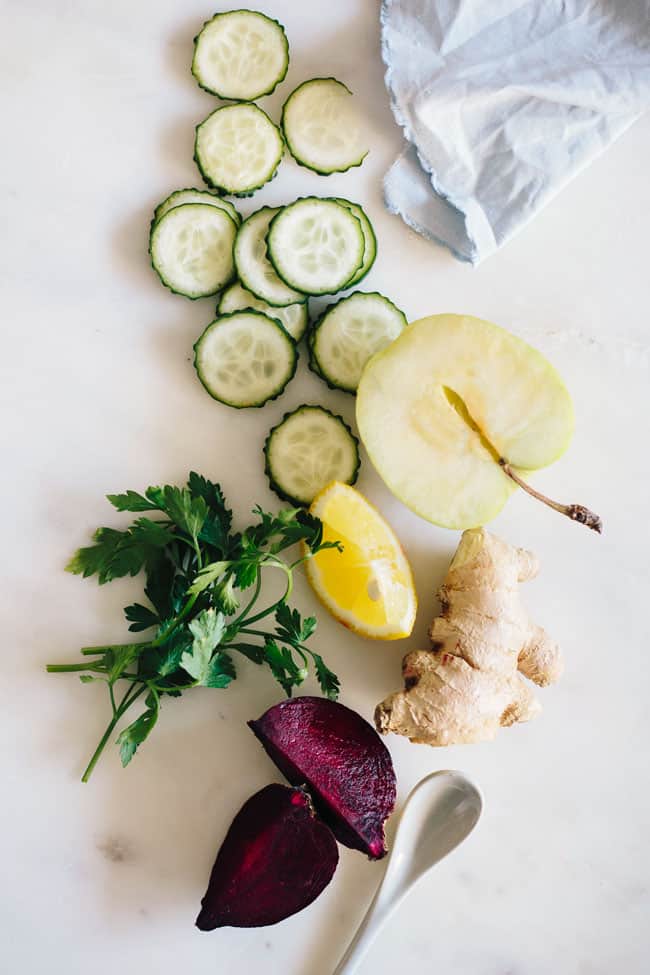
Best fruits for juicing:
Apples and pears: Add sweetness and help to balance flavors. Wash well and cut into smaller chunks. You don't need to peel (unless the fruit is waxed) or remove the core and seeds.
Pineapple: Adds a tropical flavor and contains the beneficial enzyme bromelain. Remove the skin but no need to remove the core.
Melons: Extremely hydrating and add sweet, light flavor. Remove the skin but leave the seeds.
Kiwi: High in vitamin C and adds a tartness to the juice. No need to peel them.
Oranges & Grapefruit: High in vitamin C and add a refreshing citrus flavor. Wash and peel, but don't worry about the seeds.
Lemon/Lime: Enhance flavor and add a burst of citrusy freshness. Remove the zest and seeds if desired.
Best vegetables for juicing:
Leafy greens (kale, spinach, collards, bok choy, beet greens, and other lettuces like Swiss chard): Rich in vitamins, minerals, and antioxidants. Leafy greens can taste pretty overpowering when juiced, so use them sparingly if you don't love the taste of kale or spinach.
Beets: Add natural sweetness and a vibrant color. Peel and cut into smaller pieces.
Carrots: Sweet and rich in beta-carotene. Wash and cut into chunks.
Ginger: Adds a spicy kick and has potential health benefits. No need to peel.
Cucumbers: Provide hydration and a mild, refreshing taste. Wash and add to juicer between solid veggies and fruit when possible.
Celery: Adds a mild, crisp flavor and is hydrating.
Cabbage: Mild in flavor and rich in nutrients.
Bell peppers: Add sweetness and a pop of color. Don't worry about the seeds.
Tips + Tricks for Juice Newbies
If you’re unsure where to start, seek out some tried-and-true juice recipes. Here are some juicing tips to help you get started:

1. Combine High and Low Yield Produce
As I’m sure you’ve noticed, some fruits and vegetables have a higher water content (i.e., are juicier) than others. Oranges, cucumbers, melons, carrots, beets, celery, and the like are going to produce more juice than, say, a handful of spinach.
It’s important to juice a mix of high- and low-yielding fruits and veggies. That's just juicing 101.
All fruits and veggies have vitamins, antioxidants [source], and phytonutrients, but low-juice-yielding leafy greens are especially packed full of nutrition [source]. Unfortunately, it takes a high volume of greens to yield just a few tablespoons of juice.
That’s why you see those small shots of wheatgrass juice as opposed to an 8-ounce cup. But those juices are highly concentrated, so it’s good to mix them with the juicier veggies and fruit. It also helps dilute the strong flavor, which can be a little off-putting if you’re not used to it.
2. Incorporate Sweet Veggies + Fruits
When I started juicing, I would mix just about anything together and try to choke it down.
Nope. Totally the wrong tactic.
If you’re not used to the strong flavor of juiced greens, start by using a greater proportion of fruits and vegetables that taste good and also yield more juice.
Veggies like beets, sweet potatoes, carrots, and fruits like apples, pineapples, pears, and oranges are going to add a lot of sweetness to fresh juice.
I tend to go easy on them because my body doesn’t do well with a big sugar rush. But if you’re trying to cut down on refined sugar, a sweet juice in the afternoon is a nice little pick-me-up.
3. Don't Let Stalks + Stems Go To Waste
Yes, we love leafy greens! They're full of B vitamins as well as magnesium, calcium, omega-3s, and vitamins A, C and E. However, it takes 2 cups to make 1 serving of veggies, and greens aren't the highest-yielding veggies.
So keep in mind that just because it might smell or look funky, it doesn’t mean it’s going to taste bad. That's why I always include stems and stalks from my greens when possible.
One of my favorite green juices is broccoli juice, which smells pretty much like death. But that’s just the pulp. The juice is very sweet.
And you wouldn’t believe how much juice you can get out of the light green stalks. Don’t throw those away! Juice ’em!
4. Don't Forget Cucumbers + Celery
I used to hate cucumbers until I started juicing. They're high-yield and incredibly refreshing, which turned me into a big cuke fan in a hurry.
Celery is naturally high in sodium, and the flavor is pretty strong. It’s good for juicing and will produce a good amount of juice, but go easy unless you really, really love it.
5. Yes, You Can Juice Herbs, Ginger + Garlic
You can get a lot of flavor and pep into your juice by adding small amounts of onion, garlic, ginger, turmeric, or herbs.
Don’t go crazy with the garlic unless you’re trying to scare away vampires. A little goes a long way.
Ginger is great and produces a moderate amount of juice, but it can get spicy quickly. I like it, but consider yourself warned!
Herbs are packed with nutrients and vitamins. Good herbs to add to your juices include basil, mint, cilantro, and parsley.
5. Don't Juice Soft Fruits
I don’t juice berries, mangos, bananas, and other softer fruits because they clog up my juicer. If I want to incorporate them into fresh juice, I will juice the other fruits or veggies first, then blend them up with the softer fruits in my blender.
But that's an extra step and an extra thing to wash, so I’ll usually just make a vitamin-rich smoothie instead.
Basic Healthy Juice Recipes
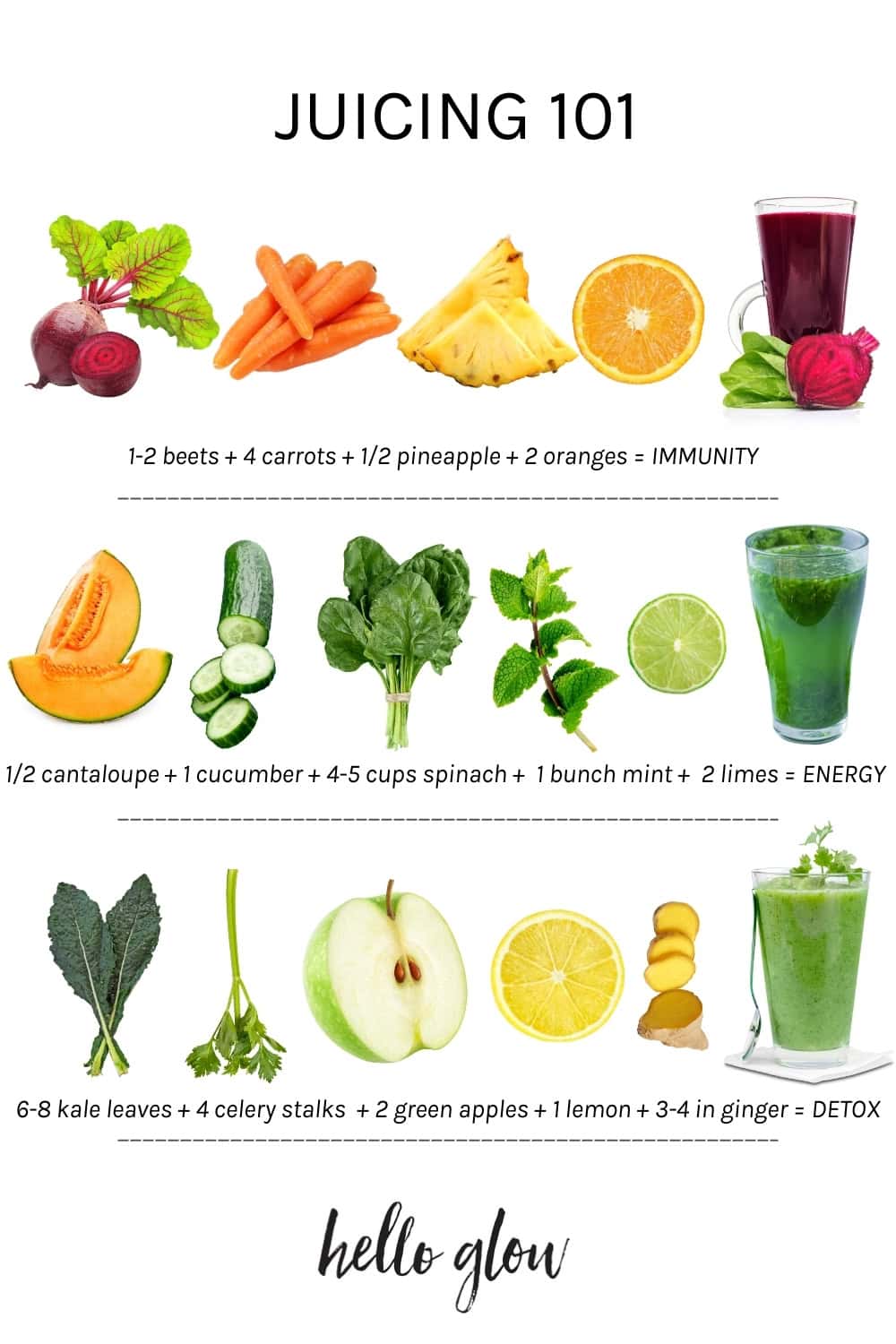
1. Tropical Immune Boost Juice
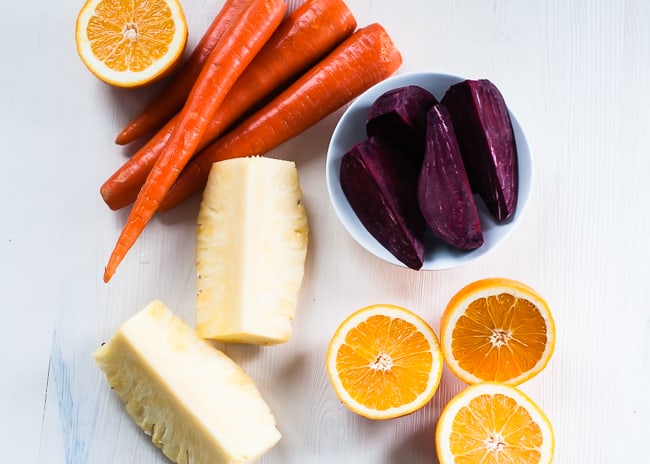
This juice is a great one for beginners because it is super sweet and delicious. Plus this refreshing fresh juice is full of vitamins A and C and other phytonutrients for beautiful skin and a healthy immune system.
Juicing Tips:
—Peel the beets or the juice will taste like dirt. (Trust me.)
—Add the beet greens for even more nutrition.
—I don’t peel the carrots but will give them a good scrub with a produce brush.
—Add ginger for that extra kick.
—This juice blend can be overly sweet depending on the fruit you use, so dilute it with water if it's too sweet for your taste. Sometimes I add sparkling water to make a fun bubbly drink.
Some juicers can’t handle big pieces of fruit or veggies, so it becomes necessary to chop the vegetables before juicing, which will add a bit to the prep time.
Beet Carrot Pineapple Orange Recipe
- 1 large or 2 small beets, peeled
- 4 large carrots
- ½ pineapple, do not remove core
- 2 medium oranges, peeled
Juice according to manufacturer directions. Serve immediately. Makes about 15–20 ounces of juice.
More Immune Boosting Juice Blends
Citrus Carrot Splash: 4 carrots, 2 oranges, 1 lemon, 1-inch ginger
Apple Beet Bliss: 2 apples, 1 beet, 2 carrots, 1 lemon
Carrot-Apple-Ginger Zing: 4 carrots, 2 apples, 1-inch ginger
Beetroot Power Punch: 1 beet, 2 apples, 1 carrot, 1 lemon, 1-inch ginger
2. Minty Melon Energizing Juice
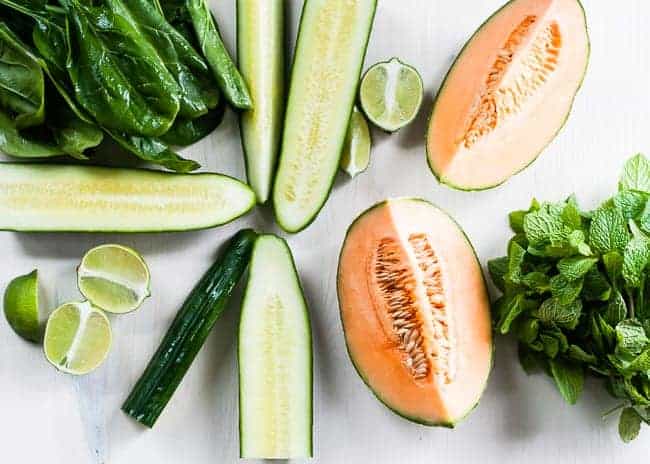
This is hands down one of my very favorite juices. It's full of vitamins and minerals with a little minty kick. I would drink it every single day if I could, and during the summer, I do.
Cucumber and melon go really well together—they are related. Adding mint and lime makes it taste like a healthy cocktail.
Juicing Tips:
—Try to use a very ripe melon for the sweetest juice. Any melon can be substituted for the cantaloupe.
—The spinach gives it some added nutrition. I don’t like to waste the stems, so I always trim and include them in the juice.
—My juicer doesn’t do a great job with citrus rind. I also find it adds a lot of bitterness to the juice, so I cut away the lime peel. But citrus rinds and seeds are edible, so you can keep them if you prefer.
Minty Cucumber Melon Recipe
- ½ medium cantaloupe, rind removed
- 1 large English cucumber, peeled if waxed
- 1 large bunch fresh spinach about 4–5 cups, stems included
- 1 small bunch fresh mint leaves and tender stems
- 2 limes, rind removed
Juice according to manufacturer directions. Serve immediately. Makes about 15–20 ounces of juice.
More Energizing Juice Blends
Apple Spinach Revitalizer: 3 green apples, 2 cups spinach, 1 cucumber, 1 lemon
Minty Melon Wake-Up: 1 cup watermelon chunks, 1 cup honeydew melon chunks, fresh mint leaves, 1 lime
Pineapple Ginger Energizer: 2 cups pineapple chunks, 1 cucumber, 1 lemon, 1-inch piece of ginger
Celery Cilantro Refresher: 4 celery stalks, 1 cup cilantro, 1 cucumber, 1 lime, 1-inch piece of ginger
3. Zingy Green Detox Juice

Mean Green Juice is one of the first juices I started making. It’s not sweet!
The celery and ginger pack a punch in this one, so it’s not for pansies. I love it because it feels zingy and helps clear things out...if you know what I mean.
Juicing Tips:
—The celery is tart and concentrated and also makes it taste a bit salty.
—I don't usually peel apples unless they are waxed. And you don't have to worry about the cores or seeds in apples or pears; they can be juiced.
—I use the kale stems too because they contain more juice than the leaves. Gritty dirt in your juice is a bummer, so I plunge leafy greens and herbs into a cold water bath and swirl them around to clean them.
—For added sweetness, add an orange or pear.
Hint: For a yummy veggie juice, sub ¼ of an onion for the ginger, and use tomatoes in place of the apples.
Mean Green Recipe
- 6–8 kale leaves, washed well and end of stems trimmed
- 4 celery stalks
- 2 green apples, peeled if waxed
- 1 lemon, rind removed
- 3–4 inches fresh ginger
Juice according to manufacturer directions. Serve immediately. Makes about 15–20 ounces of juice.
More Green Detox Juice Ideas
If you're new to green juices, start with a smaller amount of greens and gradually increase as your taste buds adjust.
Basic Beginner's Green Juice: 2 green apples, 1 cucumber, 2 handfuls of spinach, 1 lemon, 1-inch piece of ginger
Pear Spinach Juice: 1 cucumber, 2 ripe pears, 1 cup baby spinach, 1-inch piece of ginger, ½ lemon
Simple Green Goodness: 2 cucumbers, 3 celery stalks, 1 cup kale, 1 cup spinach, 1 lemon, 1-inch piece of ginger
Zesty Tomato Kale: 3 tomatoes, 2 cups kale, 1 cucumber, 1 bell pepper (any color), 1 lemon
Equipment
Any juicer will help you on your juicing journey. However, if you're serious about juicing, you might consider investing in a higher-quality juicer like this one.
If you own a high-speed blender, like a Vitamix, you don't need to cut the fruit up quite as much as with other blenders, but cutting will help regular blenders puree more quickly.
How To Juice in a Blender
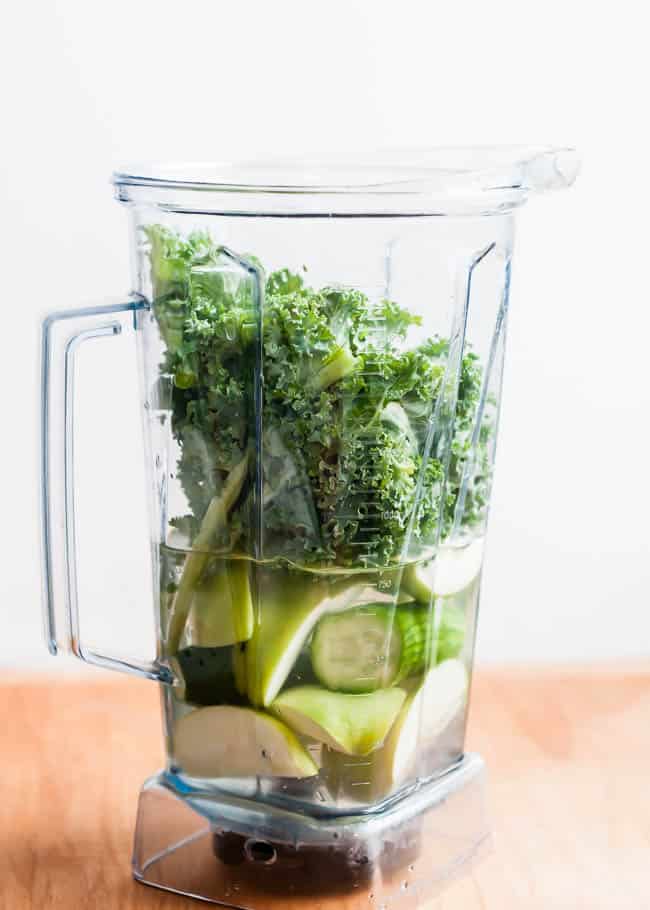
If you don't want to invest in a juicer, you can use your blender to make fresh juice. Just add 1-2 cups of water to the blender first to facilitate the blending.
Add your fruits and veggies (I place leafy greens at the very top because I think they blend better that way). Let the blender run until everything is nice and smooth. You might need to stop it a few times to scrap down the sides or adjust the speed for the smoothest puree. Then strain out the pulp with a fine mesh strainer.
Storing Fresh Juice

Fresh juice is generally best when consumed immediately. I aim to drink my juice within 24 hours. I like my juice room temp, but some folks prefer it over ice.
Juice can and will naturally separate as it sits. You can see in the picture above how much water there was in the green juice.
The upper layer is the concentrated kale juice. The rest came from the celery, lemon, and ginger. If it separates, just give it a stir and drink.
Most juices will stay good for about 3 days in the refrigerator in an airtight bottle. You can also freeze any extras.
Juicing FAQ
The physical effects of juicing might catch you off guard. I mean, it has to be said. You will probably run to the bathroom a few minutes after you drink your first juice. That’s a good thing.
One benefit is to help clear out your digestive tract and keep things moving along, even without all of the extra fiber. Don’t do a juice fast without talking to your doctor first. Once your body gets used to fresh juice, you will crave it!
Most fresh produce will do the trick, but note that leafy greens will yield a smaller quantity of juice than, say, an orange or another juicy fruit. Also note that sweet fruit is higher in sugar.
Avoid juice berries, mangos, bananas, and other softer fruits because they might clog your juicer.
📖 Recipe
3 Juice Recipes to Get You Started
Ingredients
Beet Carrot Pineapple Orange Juice
- 1 large or 2 small beets, peeled
- 4 large carrots
- ½ pineapple (do not remove core)
- 2 medium oranges, peeled and seeds removed
Minty Cucumber Melon Juice
- ½ medium cantaloupe rind and seeds removed
- 1 large English cucumber peeled if waxed
- 1 large bunch fresh spinach about 4–5 cups, stems included
- 1 small bunch fresh mint leaves and tender stems
- 2 limes rind removed
Mean Green Juice
- 6 –8 kale leaves washed well and end of stems trimmed
- 4 celery stalks
- 2 green apples peeled if waxed
- 1 lemon seeds and rind removed
- 3 –4 inches fresh ginger peeled
Instructions
- Juice all ingredients according to manufacturer directions. Serve immediately. Makes about 25–30 ounces.
Notes
References
- Slavin JL, et al. Health benefits of fruits and vegetables. Adv Nutr. 2012.
- Carlsen MH, et al. The total antioxidant content of more than 3100 foods, beverages, spices, herbs and supplements used worldwide. Nutr J. 2010.
- Roberts JL, et al. Functional properties of spinach (Spinacia oleracea L.) phytochemicals and bioactives. Food Funct. 2016.
This article was medically reviewed by Dr. Gina Jansheski, a licensed, board-certified physician who has been practicing for more than 20 years. Learn more about Hello Glow's medical reviewers here. As always, this is not personal medical advice and we recommend that you talk with your doctor.
614
